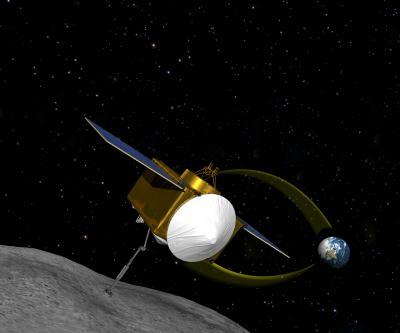The Asiris spacecraft will land on the asteroid 1999 RQ36 - a block of rock and dust with a diameter of about 600 meters that may tell us how the solar system was formed and may also shed light on the beginning of life but in addition it may one day hurt us

"This asteroid is like a time capsule from before the birth of the solar system," says Bill Cutlip of the NASA Space Center in Greenbelt, Maryland, one of the leaders of Goddard's efforts to convince decision makers to accept their proposal to launch the OSIRIS-Rex spacecraft that will fly to this asteroid and return samples from it ground.
If the project is selected, NASA's Goddard Center will provide overall mission management for Osiris-Rex, and the principal investigator will be Dr. Michael Drake, director of the Lunar and Planetary Laboratory at the University of Arizona, who leads the Osiris-Rex team. Lockheed Martin will build the spacecraft.
"It's hard to understand the great value of ancient examples," Kotlip said. Meteorites, which are pieces of asteroids that have broken up and hit the Earth, "were picked up on their way through the Earth's atmosphere," he said. "As soon as they landed, they began to suck up germs and chemicals from their environment."
"Without pure samples - especially those from an asteroid of a type not available in NASA's meteorite collection - scientists can learn more about the time before the birth of the solar system, the first stages of the formation of the planets and the source of the organic components available for the creation of life," said Dr. Joseph Knott from the center NASA's Goddard and Osiris-Rex Project Scientist.
Asteroids are remnants of the cloud of gas and dust - the solar nebula - that collapsed and created the Sun and the planets 4.5 billion years ago. As such, they contain the original materials from the solar nebula, which can tell us about the conditions that prevailed at the birth of the solar system.
In some asteroids, the materials have changed due to heating and chemical reactions either because they have collided with other asteroids or because they have grown so large that their interior has been melted. This is what makes the RQ36 unique. It is small and appears to have changed very little, retaining its appearance as in the early days of the solar system. "It is also rich in carbon, an element used in organic molecules and essential for life. Organic molecules have been found in meteorites and comets, indicating that the essential ingredients for life were formed in space. The scientists want to examine whether they are also found in RQ36.
However, returning samples is not the only goal of the mission. This asteroid crosses Earth's orbit and the International Astronomical Union's Minor Planet Center has officially classified RQ36 as a potentially hazardous asteroid that has a small - 1 in 1,800 chance of crashing into Earth in 2170.
"The spacecraft will orbit RQ36 for about a year and analyze its surface, as well as select the landing site. This will give us experience in operating a spacecraft in the vicinity of an asteroid, an experience that will be useful if we ever need to launch a spacecraft to repel such an asteroid," Noth said.
Navigating a spacecraft near an asteroid is no easy feat. Most of them are full of clumps and rotate faster than planets, which makes landing challenging. These small objects have little gravity, so other forces can significantly affect the position of the spacecraft.
"The gravity of such an asteroid is so weak that if you were to stand on the surface and wave your hand up and throw a rock, it would take half an hour for the rock to hit the ground. The pressure of solar radiation and the solar wind on the craft and its solar collectors will be equal to 20% of RQ36's gravity, meaning it will be more like a docking than a landing," Noth added.
The mission will also help track the trajectory of asteroids that may hit Earth through a more accurate calculation of the Yarkovsky effect. A Yarkovsky belt is the small boost an asteroid gets when it absorbs sunlight and emits radiation. The small push increases over time and is not uniform due to the difference in the materials that make up the surface, the oscillations and the self-rotation. There is no sure way to predict the trajectory of an asteroid approaching Earth unless it is possible to quantify how the Yarkovsky effect will change the trajectory. "It's like trying to hit a pool game and make the right ball go into the hole, when someone shakes the table and pulls their legs," Noth said.

6 תגובות
I suggest calling Bruce Willis.
Amos:
Read here:
http://en.wikipedia.org/wiki/Near-Earth_object
If many such missions are launched, it will be possible to bring the entire asteroid down to Earth (in the form of soil samples) and it will stop endangering us 🙂
Landing on a small asteroid could cause a change in trajectory that would put it on a collision course with Earth, maybe it's an unnecessary risk
Further to 2, I also think it is quite clear that by 2170 enough technological solutions will be found to prevent the collision of this type of asteroids with the Earth, but the research itself is really fascinating.
I am sure that in 2170, if we are still here, a comprehensive solution to the asteroid problem will already be found.
Not the biggest concern right now
What does it mean near the earth? I understand that the distance varies, but what order of magnitude is this?